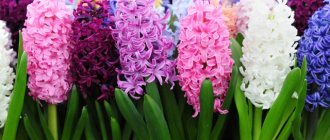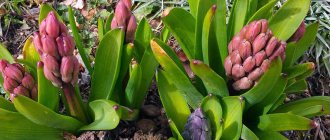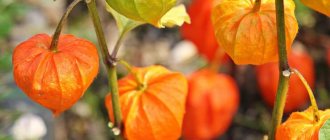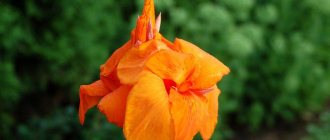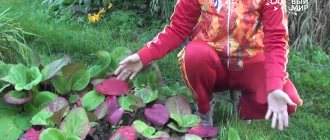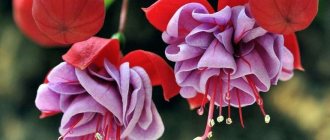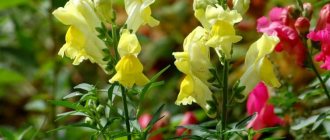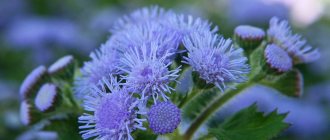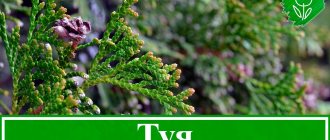Hyacinth or “rain flower” is a bulbous perennial of the Asparagus family. The culture is grown at home and on the plot, it is wonderful as a collector's item.
The sweet smell and vibrant colors of hyacinths will transform the spring garden and drive away the gloom of winter. Flower growers are always pleased with their true friends - flowers. You get up in the morning and there is a piece of living nature on the windowsill or outside the window, filling you with energy, warmth and light even on the gloomiest day.
Hyacinth - brief description
Hyacinthus hyacinths are bulbous plants up to 40 cm high. Among the long narrow leaves grows a magnificent inflorescence consisting of a group of bell-shaped flowers with a wonderful, almost stunning aroma.
This is interesting! The name comes from the hero Hyacinth from Greek mythology. Hyakinthos was the son of the Spartan king Amyklas. The beauty of the young man attracted attention, but his beautiful appearance did not save him from fate. The young man died from a blow to the head with a disk. In the place where the blood mixed with the earth, a wonderful flower grew. When the flower bloomed, Apollo named the plant after the young man.
In our climate, hyacinths grown in open ground bloom from April to May; in warmer areas, the flowering period begins in February. One hyacinth blooms for 2-3 weeks.
Attention! The number of hyacinth flowers collected in an inflorescence depends on the size of the bulb. Therefore, when purchasing, they try to choose the largest bulbs. Healthy, large specimens make it possible to obtain up to 60 flowers in an inflorescence.
Hyacinth bulbs are quite large and covered with scales. Depending on the variety, they can be creamy, red, or purple.
Botanical description of the plant
The bulbs are hard and consist of watery scales. The peduncle has no leaves and reaches a length of up to thirty centimeters; as soon as it fades, it immediately dries out along with those that grow vertically. A bud is born in the very corner of the upper bulbous leaf, and a new hyacinth will grow from it next year.
The flowers are collected in a cone-shaped form. The perianth has slightly bent flower blades, a funnel-shaped shape, and is painted in bright colors. They differ in texture into terry and smooth. The seeds are in the fruit.
Types and varieties of hyacinths
The cultivars belong to 3 different species of bulbous plants in the Asparagus family. The distribution area extends from the Middle East to northeastern Iran.
- Hyacinth Litvinowii (Hyacinthus litwinowii) is found in Turkmenistan, in northern Iran. Grows up to 20-25 cm. The leaves are lanceolate, rather wide. The flowers are small and blue. Blooms in mid or late April.
- Transcaspian dwarf hyacinth (Hyacinthus transcaspicus). The plant is native to the mountainous region between Turkmenistan and western Iran. The perennial reaches a height of 15-20 cm. The leaves spread along the ground and are quite thick. The flowers of the species are elongated and pale blue in color. There are few flowers in the inflorescence - up to 10 pieces. Above the green fleshy leaves grow light blue or dark blue flowers, collected in a loose bunch (4-10 pieces).
- Eastern Hyacinth (Hyacinthus orientalis) - only this species grows well in our Central European climate. The place of origin is considered to be the Mediterranean region. Currently grown in Europe, USA, Russia, and other parts of the world.
Oriental hyacinth includes more than 100 different varieties. Small six-rayed hyacinth flowers, the number of which is up to 40, have different colors:
- white;
- light blue;
- soft pink;
- raspberry;
- yellow;
- peach;
- orange;
- salmon;
- bright red;
- purple.
Typically one bulb produces one inflorescence. Some varieties produce several flower shoots. There are varieties with individual flowers. All hyacinths have beautiful flowers and a unique aroma. Here are a few well-known varieties, broken down by color:
| Flower color | Varieties |
| white | "Snow Crystal" Snow Christal, "White Pearl" White Pearl, "Carnegie" Carnegie |
| pink | “Freestyler” Freestyler, “Pink Pearl” Pink Pearl, “Anna Marie” Anna Marie |
| light purple | “Anastasia”Anastasia, “Crystal Palace” Christal Palace, “Amethyst” Ametist |
| red | "Holly Hook" Holly Hook, "Jan Bos" Jan Bos |
| blue | "General Köhler" General Köhler, "Blue Jacket" Blue Jacket |
| salmon | “Prince of Love” Prince of Love, “Gypsy Queen” Gipsy Queen |
| yellow | "City of Haarlem" City of Haarlem, "Yellow Queen" Yellow Queen |
| orange | "Gypsy Queen" Gipsy Queen |
Growing and caring for hyacinths in open ground
Colorful and fragrant, hyacinths are fortunately easy to grow. Plants are not too picky about soil conditions.
- Landing place. Like all spring flowers, hyacinths love sunny positions. Choose a place that is warm, sunny, possibly slightly shaded, and always protected from the winds. In the sun, the flowers bloom better, the inflorescences are compact and dense, in the shade the plant stretches out, the inflorescences become thinner.
- Soils . Soil care is easy. It is necessary to prepare fertile substrates, not acidic, not too wet. It is ideal to add compost soil under the bulbs. Since compost contains a sufficient amount of nutrients, the next feeding of the plant with organic fertilizers can be skipped.
- Fertilizer . In addition to adding compost, other fertilizers are applied during planting. In the spring, after the start of growth, nitrogen is given - ammonium nitrate. Subsequently, multicomponent fertilizers are used.
- Winter care . The plants are resistant to frost; no special measures are required in winter. Bulbs of some sensitive varieties need to be covered with a layer of straw, branches or special non-woven material after autumn planting.
- Watering. The plant tolerates spring showers without damage. When the first shoot tips appear, the soil should be moist. However, excess water can be harmful. In summer, flowers are watered less; in summer, the plant prefers dry soil.
- Trimming. Inflorescences bloom from March to April. When the inflorescences fade in May, they need to be cut off so that they do not produce seeds, this takes a lot of resources from the plant (plastic substances).
Planting and propagation of hyacinths in autumn
Autumn is the optimal time to plant hyacinths. The plant reproduces by bulbs. It is important to observe planting dates correctly. The best months to plant hyacinth bulbs are October. The ground is still quite warm and the bulbs have plenty of time to settle into their new location. The end of November is the latest date.
The basic principle of planting hyacinths is that they should not be planted after:
- cucumbers;
- tomatoes;
- strawberries
Otherwise, mold spores and pathogenic fungi that are dangerous for the bulbs of these flowers remain in the ground.
Gardeners often plant plants in lightly shaded areas so they bloom longer.
Before planting hyacinths in the fall, you need to dig up the soil with compost. As a natural fertilizer, it will improve the quality of the soil and its properties. Compost optimizes the flowering phase of the bulbous plant. Additional addition of organic matter can negatively affect the growth of hyacinths.
Only healthy, firm and unsprouted bulbs should be planted. A coating of mold, wrinkled, dry husks, discoloration, and the smell of rot are a signal that a large flower will not grow from the bulb. When planting, you must be careful not to damage the planting material. It is advisable to treat the bulbs with a fungicide such as Funaben before planting.
It is important at what depth to plant hyacinths. The planting depth should be equal to twice the diameter of the bulb. Don't plant the bulbs too close together - about 10cm apart is ideal.
Depending on the size of the bulbs, the planting depth can be 10-20 cm, and the distance between the bulbs can be 15-25 cm.
Remember to plant the hyacinth bulbs bottom down and tail up.
Timely planting will provide better conditions for rooting and development. If there was no time to plant bulbs in the fall, it is possible to plant hyacinths in the spring. But only when the likelihood of frost has passed.
Do I need to dig up the bulbs?
Hyacinths can be grown in several ways:
- Dig up the bulbs every year to give them a rest;
- Do not dig it out of the ground - this is a more convenient method, although in subsequent years the flowers will be smaller and then disappear completely.
To maintain flowering plants, bulbs need to be dug up. Gardeners recommend annually digging up the bulbs and replanting them in a new location.
You can choose a compromise version and dig up the bulbs every few years to “rest”.
Story
Hyacinth is native to Asia . It first appeared during the Roman Empire. In the 16th century, sailors brought the seeds of this representative of the flora to their homeland. The plant has taken root well in the humid and mild climate of Holland. It was loved by rich merchants for its extraordinary fragrant aroma. The plant immediately gained wide popularity. In the 17th century, new subspecies of the plant appeared. And by the 18th century, Hyacinth had more than 2,000 different varieties.
All plants had magnificent fragrant flowers that differed in color. A wonderful color scheme was developed. There were both ordinary flowers and plants with double leaves. Some of them even had several main peduncles. At the moment, the main suppliers of seeds and other planting material are Holland and England.
Features of planting and care in pots
Hyacinths grow equally well in garden beds and in home pots. You can enjoy the wonderful scent and colors of the flowers on your terrace or even at home. The planting period for pots is the same as in the garden - October-November. The substrate must be fertile, then fertilizing is not needed. Composted soil mixed with sand is used successfully. A drainage layer is placed at the bottom of the pots to drain excess water.
The bulbs are planted in a pot or container so that they do not touch each other. The planting depth is equal to twice the diameter of the bulb. To ensure that the soil adheres well to the bulbs, it is lightly watered. The pots are then placed in a cool, dark room for 10 weeks. During this period, the plants are watered very moderately.
Caring for young plants. When shoots begin to emerge from the ground, the flowers must be exposed to light. The pots are placed on the windowsills, saturating the plants with the warmth of the sun's rays through the glass. The larger the plant gets, the more water it needs. That is, the substrate should be constantly damp, but not wet. To retain moisture, moss is placed on the ground, which decorates the pot in an interesting way. The heavier inflorescences are tied to supports.
How to properly care for winter?
In May, when the colorful inflorescences lose their charm, they are cut off. The green leaves are left until they turn completely yellow and wilt. Then they are removed. When the hyacinth has bloomed, the bulb collects the necessary materials for wintering and the next season through the leaves.
Hyacinth bulbs can be left in the ground and the soil can be fed with compost in the fall. If the flowers are to be moved to another location in the garden, the bulbs are dug up and stored in a dark, dry place during the summer. In October you can plant them in a new place.
Hyacinth is a frost-resistant plant, but the problem lies in fairly frequent weather changes and snowless periods. Before the arrival of winter, it is advisable to mulch the soil over the planted hyacinth bulbs, which will protect them from freezing (especially necessary for growing unstable varieties).
9.Note
Hyacinths can be kept indoors for several years, but more often they are transplanted into the garden after flowering.
Essential oil is obtained from hyacinth flowers , which has many beneficial properties - it is used, for example, in perfumes and creams, as it can soften and moisturize the skin.
The essential oil also has a tonic effect and has calming properties, which is why it is used in aromatherapy.
Hyacinth bulbs contain poisonous juice , which in turn carries a certain amount of oxalic acid, which can irritate the skin of the hands - use protective gloves when transplanting plants.
If ingested, the plant juice can cause poisoning , the symptoms of which will be diarrhea and vomiting.
↑ Up,
After flowering
In spring, hyacinths become a real decoration. When the spectacular blooms disappear and the unique aroma disappears, it is time to prepare the plants for the next season. The pots are moved to a secluded place and watered moderately until the above-ground parts disappear naturally. The bulbs should then be dug up, dried and stored in paper bags in a dry, dark place during the summer. In September-October you can plant them again and wait for the next miracle of flowering.
In May, garden hyacinths have their inflorescences cut off, as described above.
8.Purpose
Growing different varieties of hyacinth in one container always gives impressive results.
An excellent forcing plant , from planting to flowering it takes on average about 2.5 months, therefore you can get a flowering plant for any holiday.
Hyacinth petals are added to lotion and are believed to help get rid of wrinkles.
Plant flowers are also an excellent natural flavoring agent for indoor use.
↑ Up,
Hyacinth diseases
Leaves, inflorescences and bulbs are subject to various diseases:
- fungal;
- bacterial;
- viral.
The most common diseases:
- blossom end rot - caused by soil pathogens;
- gray mold;
- wet rot;
- bulb rot - penicillosis of bulbs;
- hyacinth mosaic.
Plant bulbs are stored in a cool, dry place. Particular attention should be paid to bulbs with small round yellow spots under the husk or light brown spots blending into larger spots. The former probably means infection of the bulb with gray mold, the latter - dry rot. It is better to throw them away because by putting them back in the ground we will infect other hyacinths with both fungal diseases. Bulbs should always be treated with a fungicide before planting.
Meaning
Hyacinth is named after the beloved Apollo, who turned a young man killed by the jealous god of the wind into a beautiful flower.
Originating in the East and becoming popular in Victorian Europe, the language of flowers states that hyacinth means tenderness, joy, impetuousness, renewal .
But a lot depends on the color:
- a yellow man gives a gift to a woman he is jealous of;
- orange can be given to anyone - it symbolizes pure joy without romantic overtones or the desire to protect.
Hyacinths in landscape design, photos - examples of flower bed design
Hyacinth flowers are among the most popular garden plants. This is due to the richness of the flowers and ease of cultivation. Planted in groups of the same color, these beautiful flowers create impressive colorful displays in flower beds. They also look good in pots and wicker baskets.
Photo. Flower beds and flower beds with hyacinths
When planning a large flower bed, it is worth planting hyacinths in groups - several, a dozen or so bulbs of the same variety. Flowers will create spectacular, colorful islands.
By choosing flowering varieties at the same time, you can achieve the effect of a patterned carpet or scarf.
Hyacinth is a wonderful decoration for any garden, summer cottage, or small flower bed. The plant is easy to grow, planting the bulbs does not involve any special measures, caring for the shoots is simple, regular watering is required, especially during periods of drought. These extremely beautiful plants are probably a favorite in the spring, producing extremely gorgeous blooms that are intensely colored and fragrant. It's no wonder that many people want to grow this charming bulbous plant in the garden or in pots at home.
